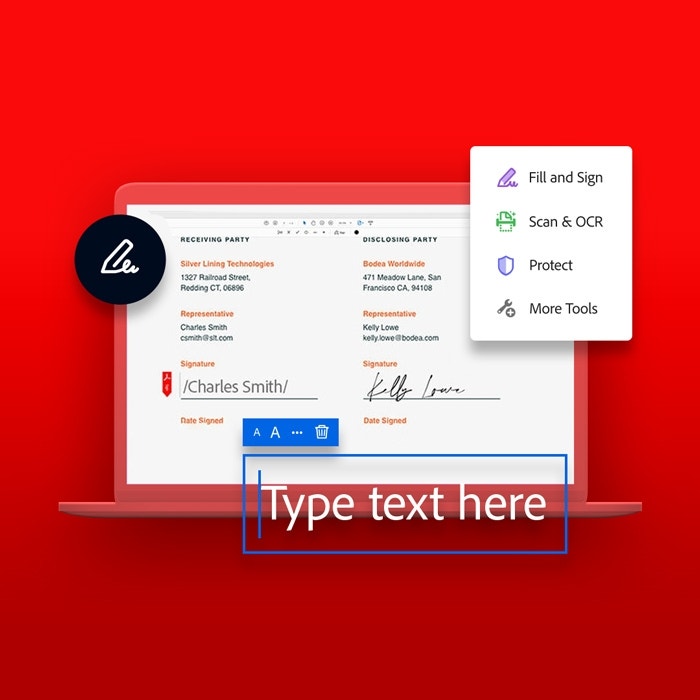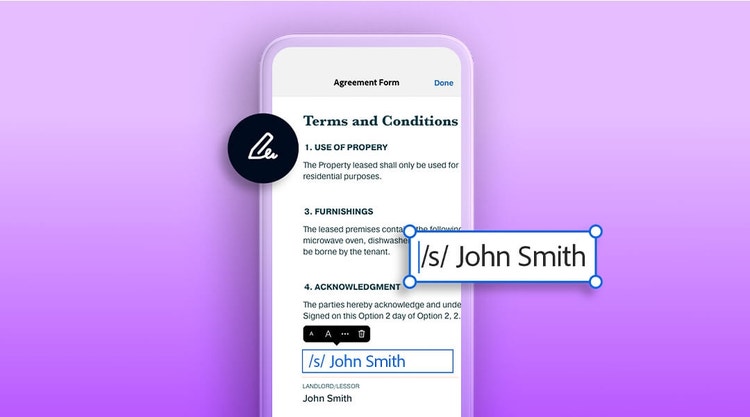Acrobat for business
What is an /s/ signature and how can it help?
Keep contracts moving with these typed signatures. Or bypass s-signatures with Adobe Acrobat, which makes it easy to add a handwritten signature to any doc.

What is an s-signature?
Before we define an /s/ signature, let's refresh our answer for what is a signature. A signature is a representation of a person's name, nickname, or sometimes even a simple "X" or any other symbol that an individual writes on documents to confirm their identity. s-signature is a way to sign an electronic document using a typed signer’s name instead of an actual signature. The signer types their name on the signature line of a document between two forward slashes (for example, /Jimmy Doe/).
In the case of conformed signatures, which are another type of s-signature, the signer puts an “s” between two forward slash marks in front of their typed name (for example, /s/ Jimmy Doe). In fact, the s-signature name took its name from the conformed signature style.
Why use s-signatures?
Flexibility
Electronic signatures are necessary to keep business moving, especially when you can’t meet face to face. You never want technical issues to get in the way of collecting signatures. An s signature makes it simple to collect, regardless of a person’s device or tech savviness.
Convenience
Depending on where and how you are doing business, the option of an s-signature may help you conduct business more quickly by speeding up the signing process. For example, when you’re e-filing a patent application, you can quickly use a form-fill app to add a digital signature from any keyboard. This is just one of many possible examples of when an s-signature might work better than a wet signature.

How to use an /s/ signature
While s-signatures are relatively easy to add to an electronic document, the signatory (the person signing) should consider the following:
- Sign only using letters, Arabic numerals, or a combination of both in your s-signature.
- Use the appropriate spacing between words.
- Include any other necessary punctuation (commas, periods, hyphens).
Remember, the signature must be between forward slashes to make it valid. You must add an s-signature for yourself. Another party cannot add it.
Regulations
The rules around e-signature validity vary from country to country and region to region.
For example, there are many laws that cover the validity of e-signatures in the United States. The Uniform Electronic Transactions Act (UETA) in 1999 and the US Electronic Signatures in Global and National Commerce (ESIGN) Act in 2000 both set regulatory guidelines on electronic signatures, but every state has not adopted these.
The United States Patent and Trademark Office (USPTO) and many other government agencies accept s-signatures for electronic filing. The Manual of Patent Examining Procedures (MPEP) 501 and 502 also covers regulations on s-signatures for patents.
As always, consult your attorney for advice on using an s-signature relevant to your use case.

Add s-signatures with Adobe Fill & Sign.
If you need to add an s-signature to an electronic document while working on your desktop, it’s a fast and easy workflow.
01. Open your form in Acrobat.
02. In the sidebar menu, select Edit PDF. Or, in the top menu, select the Edit Text & Images icon, which looks like a pen on a piece of paper.
03. Whether the form is digital or scanned, Adobe Acrobat Optical Character Recognition will identify forms on the field and make all text editable.
04. Click the form where you need to add an s-signature and type it in.

01. Open your form in the Adobe Fill & Sign app.
02. Click the space where you need to add the s-signature.
Create your own handwritten e-signature.
In instances where a handwritten-looking signature is required, you can easily use one that you can create in Acrobat. It's quick and easy to use Acrobat's online signature generator tool, which allows you to choose from multiple font styles or even draw your own signature.
There are many pre-designed fonts that mimic handwriting styles, giving the signature a personal, authentic look. Additionally, you can upload a scanned image of your handwritten signature to use it digitally, ensuring it resembles the original appearance while maintaining the benefits of an electronic signature.
